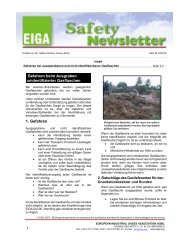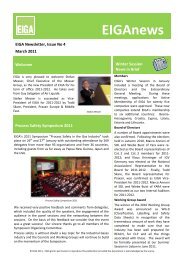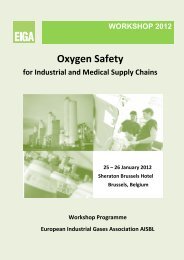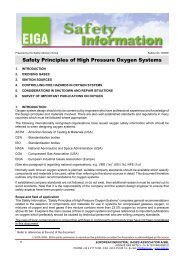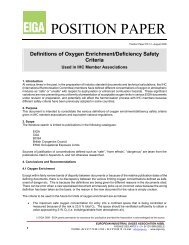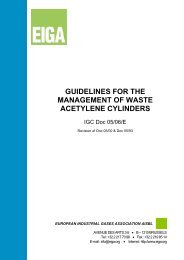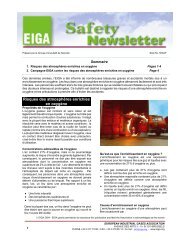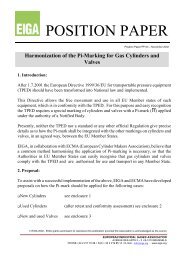CODE OF PRACTICE DRY ICE - eiga
CODE OF PRACTICE DRY ICE - eiga
CODE OF PRACTICE DRY ICE - eiga
You also want an ePaper? Increase the reach of your titles
YUMPU automatically turns print PDFs into web optimized ePapers that Google loves.
IGC DOC 150/08<br />
5.2 Hazards<br />
Asphyxiation<br />
Carbon Dioxide is classified as a non-flammable, non-toxic liquefied gas. It is normally present in<br />
atmospheric air at a level of approximately 380 parts per million (0,038 %). It is a normal product of<br />
metabolism being held in bodily fluids and tissues where it forms part of the bodies normal chemical<br />
environment. In the body it acts in the linking of respiration, circulation and vascular response to the<br />
demands of metabolism both at rest and in exercise.<br />
The effects of inhaling low concentrations of carbon dioxide are physiological reversible but in high<br />
concentrations the effects are toxic and damaging.<br />
Note: The effects of carbon dioxide are entirely independent of the effects of oxygen deficiency.<br />
The oxygen content in the atmosphere is therefore not an effective indication of the danger. It is<br />
possible to have an acceptable low oxygen content of 18% and a high carbon dioxide content, 14 %<br />
being very dangerous.<br />
Individual tolerances can vary widely, dependent on the physical condition of the person and the<br />
temperature and humidity of the atmosphere, but as a general guide, the effects of inhaling varying<br />
concentrations of carbon dioxide are likely to be as follows:<br />
Concentrations by volume - likely effects:<br />
1-1.5% Slight effect on chemical metabolism after exposure of several hours.<br />
3% The gas is weakly narcotic at this level, giving rise to deeper breathing, reduced hearing<br />
ability, coupled with headache, an increase in blood pressure and pulse rate.<br />
4-5% Stimulation of the respiratory centre occurs resulting in deeper and more rapid breathing.<br />
Signs of intoxication will become evident after 30 minutes exposure.<br />
5-10% Breathing becomes more laborious with headache and loss of judgement.<br />
10-100% When the carbon dioxide concentration increases above 10% unconsciousness will<br />
occur in under one minute and, unless prompt action is taken, further exposure to these<br />
high levels will eventually result in death.<br />
The recommended operational exposure limit for carbon dioxide is 5.000 parts per million (0,5%) by<br />
volume, calculated on an 8 hour time weighted average concentration in air.<br />
Depending on regulations in individual countries, carbon dioxide concentration peaks up to 30000<br />
parts per million (3%) in air are allowed, whereby the duration of exposure is between 10 minutes and<br />
1 hour.<br />
Cardiac or respiratory defects are likely to increase the hazards of inhalation.<br />
Wherever any doubt exists, the recommended exposure limit of 5000 parts per million carbon dioxide<br />
in air should be regarded as the maximum level of the individual concerned.<br />
Low temperature of product: Extreme cold<br />
Dry ice is extremely cold (-78,5°C) and may cause frostbite if touched without protection. If dry ice<br />
particles come into contact with the eyes, severe eye injury may result.<br />
Touching pipes and installations containing liquid carbon dioxide may cause frostbite.<br />
Where there has been a major release of gas, visibility is likely to be limited due to the fog formed by<br />
the condensation of water vapour in the air and there is a risk of asphyxiation. These factors can<br />
make escape or rescue difficult.<br />
6 Specific requirements for dry ice for food applications<br />
Note: The following applies specifically to food application. For non-food applications there are no<br />
specific requirements.<br />
4



